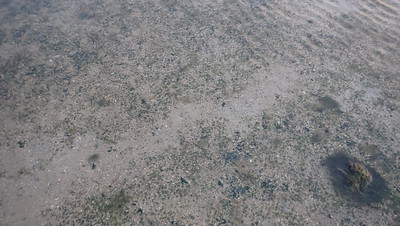On the last morning super low tide of the year, we return to our favourite shore!
We survey the eastern shore of this huge submerged reef flat and saw dugong feeding trails, many large Knobbly sea stars, four Giant clam. Also cushion stars, cone snail and blue bioluminescence! The corals seem to be doing well, although the seagrass situation has not recovered.
The seagrass cover on Cyrene has grown very thin compared to the past. Despite this, I saw some furrows that look like they were made by feeding dugong in the seagrasses facing Pasir Panjang Container Terminals. Which I could only photograph well after sunrise. Fortunately Kelvin flew the drone can got a much better view of the extent of dugong feeding trails in the area.
These trails are formed when dugongs chomp up seagrasses including their roots, leaving a shallow meandering furrow of about equal width and depth. I saw similar trails on our last survey here in Dec 2021 and Aug 2021.
It is actually easier to find Giant clams in the dark than in broad daylight. So, not surprisingly I managed to find the three large Fluted giant clams that we missed on our last daylight survey here in Dec 2021. The ones I saw were about 30cm, 35cm plus a huge one at about 40cm.
The rest of the team saw a smaller one on the reef edge facing the container terminal.
There are still many Knobbly sea stars near the beacon, as well as a few on the shore facing the container terminal. I saw about 15.There's never been a lot of hard corals on Cyrene since we first started surveying it. But there were some, and they seemed alright. Mostly boulder shaped species, some were very large (nearly 1m in diameter). I didn't see any that were bleaching.There were also many medium-sized colonies of leathery soft corals of various kinds. And some flowery soft corals, some with tiny bright orange brittle stars. I didn't see any that were bleaching.In the dark, fishes are less skitish and easier to find and photograph. I saw a baby barracuda and a large Copperband butterflyfish. The rest of the team saw pretty fish, cone snail, cushion stars, octopus and more. Jianlin observed blue bioluminescence! Other common reef animals were also seen.
There was still good seagrass cover on the Eastern end of Cyrene facing the container terminal. Mostly Spoon seagrass and other shorter seagrasses. Tape seagrasses were few and far between, with cropped leaf blades.
The deep pool is surrounded by bare sand now. The centre of Cyrene is almost completely devoid of seagrass now. In the sand, there remains signs of life. Including Cake sand dollars, Common sea stars, Sand bubbler crabs and various worm signs.
Instead of a bloom of Sargassum which is common this time of the year, there was a bloom of Hairy green seaweed along the eastern waterline.
Although it lies in the middle of an industrial triangle and major shipping lanes, Cyrene has some of Singapore's most amazing shores.
More photos by others on the survey
Jianlin Liu
James Koh
Richard Kuah
Kelvin Yong
Che Cheng Neo
Tammy Lim
Others on this survey: Jonathan Tan












